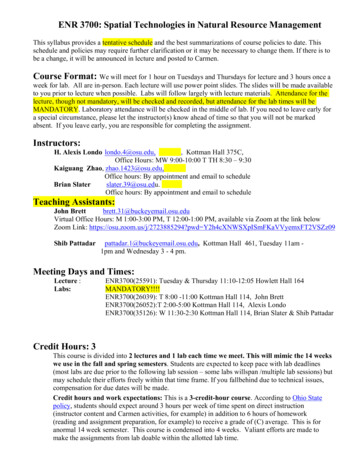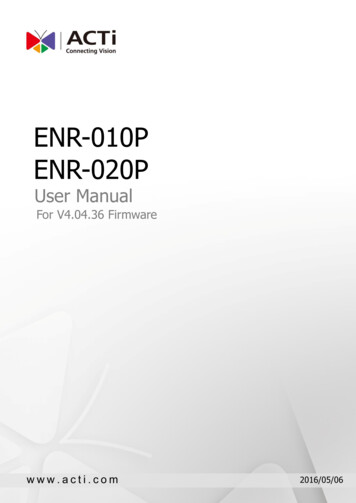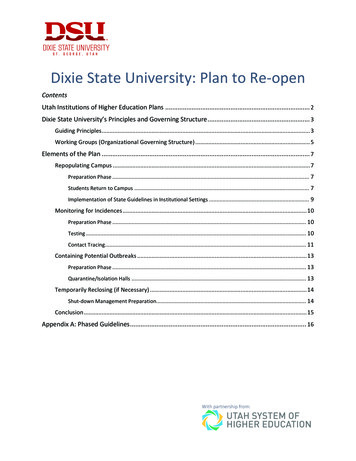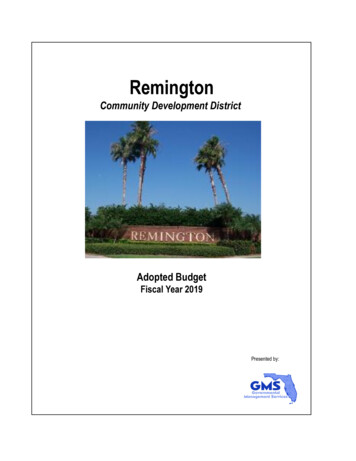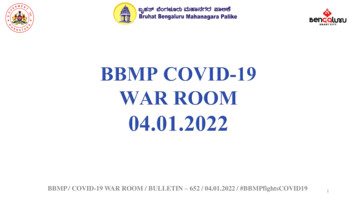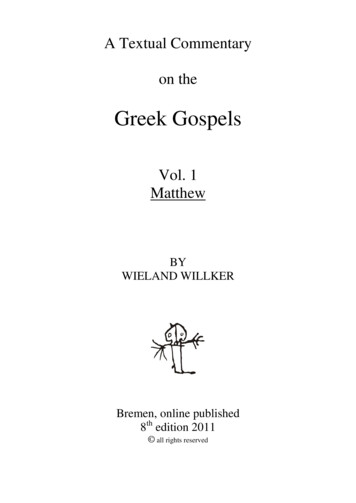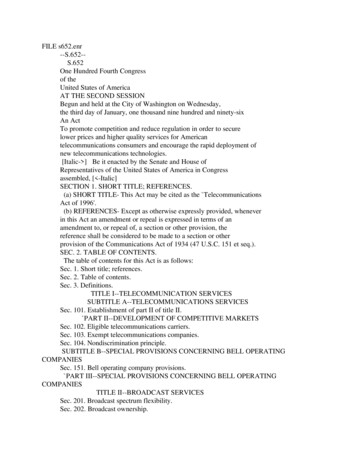
Transcription
FILE s652.enr--S.652-S.652One Hundred Fourth Congressof theUnited States of AmericaAT THE SECOND SESSIONBegun and held at the City of Washington on Wednesday,the third day of January, one thousand nine hundred and ninety-sixAn ActTo promote competition and reduce regulation in order to securelower prices and higher quality services for Americantelecommunications consumers and encourage the rapid deployment ofnew telecommunications technologies.[Italic- ] Be it enacted by the Senate and House ofRepresentatives of the United States of America in Congressassembled, [ -Italic]SECTION 1. SHORT TITLE; REFERENCES.(a) SHORT TITLE- This Act may be cited as the TelecommunicationsAct of 1996'.(b) REFERENCES- Except as otherwise expressly provided, wheneverin this Act an amendment or repeal is expressed in terms of anamendment to, or repeal of, a section or other provision, thereference shall be considered to be made to a section or otherprovision of the Communications Act of 1934 (47 U.S.C. 151 et seq.).SEC. 2. TABLE OF CONTENTS.The table of contents for this Act is as follows:Sec. 1. Short title; references.Sec. 2. Table of contents.Sec. 3. Definitions.TITLE I--TELECOMMUNICATION SERVICESSUBTITLE A--TELECOMMUNICATIONS SERVICESSec. 101. Establishment of part II of title II. PART II--DEVELOPMENT OF COMPETITIVE MARKETSSec. 102. Eligible telecommunications carriers.Sec. 103. Exempt telecommunications companies.Sec. 104. Nondiscrimination principle.SUBTITLE B--SPECIAL PROVISIONS CONCERNING BELL OPERATINGCOMPANIESSec. 151. Bell operating company provisions. PART III--SPECIAL PROVISIONS CONCERNING BELL OPERATINGCOMPANIESTITLE II--BROADCAST SERVICESSec. 201. Broadcast spectrum flexibility.Sec. 202. Broadcast ownership.
Sec. 203. Term of licenses.Sec. 204. Broadcast license renewal procedures.Sec. 205. Direct broadcast satellite service.Sec. 206. Automated ship distress and safety systems.Sec. 207. Restrictions on over-the-air reception devices.TITLE III--CABLE SERVICESSec. 301. Cable Act reform.Sec. 302. Cable service provided by telephone companies. PART V--VIDEO PROGRAMMING SERVICES PROVIDED BY TELEPHONECOMPANIESSec. 303. Preemption of franchising authority regulation oftelecommunications services.Sec. 304. Competitive availability of navigation devices.Sec. 305. Video programming accessibility.TITLE IV--REGULATORY REFORMSec. 401. Regulatory forbearance.Sec. 402. Biennial review of regulations; regulatory relief.Sec. 403. Elimination of unnecessary Commission regulations andfunctions.TITLE V--OBSCENITY AND VIOLENCESUBTITLE A--OBSCENE, HARASSING, AND WRONGFUL UTILIZATION OFTELECOMMUNICATIONS FACILITIESSec. 501. Short title.Sec. 502. Obscene or harassing use of telecommunications facilitiesunder the Communications Act of 1934.Sec. 503. Obscene programming on cable television.Sec. 504. Scrambling of cable channels for nonsubscribers.Sec. 505. Scrambling of sexually explicit adult video serviceprogramming.Sec. 506. Cable operator refusal to carry certain programs.Sec. 507. Clarification of current laws regarding communication ofobscene materials through the use of computers.Sec. 508. Coercion and enticement of minors.Sec. 509. Online family empowerment.SUBTITLE B--VIOLENCESec. 551. Parental choice in television programming.Sec. 552. Technology fund.SUBTITLE C--JUDICIAL REVIEWSec. 561. Expedited review.TITLE VI--EFFECT ON OTHER LAWSSec. 601. Applicability of consent decrees and other law.Sec. 602. Preemption of local taxation with respect todirect-to-home services.TITLE VII--MISCELLANEOUS PROVISIONSSec. 701. Prevention of unfair billing practices for information or
services provided over toll-free telephone calls.Sec. 702. Privacy of customer information.Sec. 703. Pole attachments.Sec. 704. Facilities siting; radio frequency emission standards.Sec. 705. Mobile services direct access to long distance carriers.Sec. 706. Advanced telecommunications incentives.Sec. 707. Telecommunications Development Fund.Sec. 708. National Education Technology Funding Corporation.Sec. 709. Report on the use of advanced telecommunications servicesfor medical purposes.Sec. 710. Authorization of appropriations.SEC. 3. DEFINITIONS.(a) ADDITIONAL DEFINITIONS- Section 3 (47 U.S.C. 153) is amended-(1) in subsection (r)-(A) by inserting (A)' after means'; and(B) by inserting before the period at the end thefollowing: , or (B) comparable service provided through asystem of switches, transmission equipment, or otherfacilities (or combination thereof) by which a subscribercan originate and terminate a telecommunications service';and(2) by adding at the end thereof the following: (33) AFFILIATE- The term affiliate' means a person that(directly or indirectly) owns or controls, is owned orcontrolled by, or is under common ownership or control with,another person. For purposes of this paragraph, the term own'means to own an equity interest (or the equivalent thereof) ofmore than 10 percent. (34) AT&T CONSENT DECREE- The term AT&T Consent Decree'means the order entered August 24, 1982, in the antitrustaction styled United States v. Western Electric, Civil ActionNo. 82-0192, in the United States District Court for theDistrict of Columbia, and includes any judgment or order withrespect to such action entered on or after August 24, 1982. (35) BELL OPERATING COMPANY- The term Bell operatingcompany'- (A) means any of the following companies: Bell TelephoneCompany of Nevada, Illinois Bell Telephone Company, IndianaBell Telephone Company, Incorporated, Michigan BellTelephone Company, New England Telephone and TelegraphCompany, New Jersey Bell Telephone Company, New YorkTelephone Company, U S West Communications Company, SouthCentral Bell Telephone Company, Southern Bell Telephone andTelegraph Company, Southwestern Bell Telephone Company, TheBell Telephone Company of Pennsylvania, The Chesapeake and
Potomac Telephone Company, The Chesapeake and PotomacTelephone Company of Maryland, The Chesapeake and PotomacTelephone Company of Virginia, The Chesapeake and PotomacTelephone Company of West Virginia, The Diamond StateTelephone Company, The Ohio Bell Telephone Company, ThePacific Telephone and Telegraph Company, or WisconsinTelephone Company; and (B) includes any successor or assign of any such companythat provides wireline telephone exchange service; but (C) does not include an affiliate of any such company,other than an affiliate described in subparagraph (A) or (B). (36) CABLE SERVICE- The term cable service' has the meaninggiven such term in section 602. (37) CABLE SYSTEM- The term cable system' has the meaninggiven such term in section 602. (38) CUSTOMER PREMISES EQUIPMENT- The term customerpremises equipment' means equipment employed on the premises ofa person (other than a carrier) to originate, route, orterminate telecommunications. (39) DIALING PARITY- The term dialing parity' means that aperson that is not an affiliate of a local exchange carrier isable to provide telecommunications services in such a mannerthat customers have the ability to route automatically, withoutthe use of any access code, their telecommunications to thetelecommunications services provider of the customer'sdesignation from among 2 or more telecommunications servicesproviders (including such local exchange carrier). (40) EXCHANGE ACCESS- The term exchange access' means theoffering of access to telephone exchange services or facilitiesfor the purpose of the origination or termination of telephonetoll services. (41) INFORMATION SERVICE- The term information service'means the offering of a capability for generating, acquiring,storing, transforming, processing, retrieving, utilizing, ormaking available information via telecommunications, andincludes electronic publishing, but does not include any use ofany such capability for the management, control, or operationof a telecommunications system or the management of atelecommunications service. (42) INTERLATA SERVICE- The term interLATA service' meanstelecommunications between a point located in a local accessand transport area and a point located outside such area. (43) LOCAL ACCESS AND TRANSPORT AREA- The term local accessand transport area' or LATA' means a contiguous geographicarea--
(A) established before the date of enactment of theTelecommunications Act of 1996 by a Bell operating companysuch that no exchange area includes points within more than1 metropolitan statistical area, consolidated metropolitanstatistical area, or State, except as expressly permittedunder the AT&T Consent Decree; or (B) established or modified by a Bell operating companyafter such date of enactment and approved by the Commission. (44) LOCAL EXCHANGE CARRIER- The term local exchangecarrier' means any person that is engaged in the provision oftelephone exchange service or exchange access. Such term doesnot include a person insofar as such person is engaged in theprovision of a commercial mobile service under section 332(c),except to the extent that the Commission finds that suchservice should be included in the definition of such term. (45) NETWORK ELEMENT- The term network element' means afacility or equipment used in the provision of atelecommunications service. Such term also includes features,functions, and capabilities that are provided by means of suchfacility or equipment, including subscriber numbers, databases,signaling systems, and information sufficient for billing andcollection or used in the transmission, routing, or otherprovision of a telecommunications service. (46) NUMBER PORTABILITY- The term number portability' meansthe ability of users of telecommunications services to retain,at the same location, existing telecommunications numberswithout impairment of quality, reliability, or convenience whenswitching from one telecommunications carrier to another. (47) RURAL TELEPHONE COMPANY- The term rural telephonecompany' means a local exchange carrier operating entity to theextent that such entity- (A) provides common carrier service to any localexchange carrier study area that does not include either- (i) any incorporated place of 10,000 inhabitants ormore, or any part thereof, based on the most recentlyavailable population statistics of the Bureau of theCensus; or (ii) any territory, incorporated or unincorporated,included in an urbanized area, as defined by the Bureauof the Census as of August 10, 1993; (B) provides telephone exchange service, includingexchange access, to fewer than 50,000 access lines; (C) provides telephone exchange service to any localexchange carrier study area with fewer than 100,000 accesslines; or
(D) has less than 15 percent of its access lines incommunities of more than 50,000 on the date of enactment ofthe Telecommunications Act of 1996. (48) TELECOMMUNICATIONS- The term telecommunications' meansthe transmission, between or among points specified by theuser, of information of the user's choosing, without change inthe form or content of the information as sent and received. (49) TELECOMMUNICATIONS CARRIER- The term telecommunications carrier' means any provider oftelecommunications services, except that such term does notinclude aggregators of telecommunications services (as definedin section 226). A telecommunications carrier shall be treatedas a common carrier under this Act only to the extent that itis engaged in providing telecommunications services, exceptthat the Commission shall determine whether the provision offixed and mobile satellite service shall be treated as commoncarriage. (50) TELECOMMUNICATIONS EQUIPMENT- The term telecommunications equipment' means equipment, other thancustomer premises equipment, used by a carrier to providetelecommunications services, and includes software integral tosuch equipment (including upgrades). (51) TELECOMMUNICATIONS SERVICE- The term telecommunications service' means the offering oftelecommunications for a fee directly to the public, or to suchclasses of users as to be effectively available directly to thepublic, regardless of the facilities used.'.(b) COMMON TERMINOLOGY- Except as otherwise provided in this Act,the terms used in this Act have the meanings provided in section 3of the Communications Act of 1934 (47 U.S.C. 153), as amended bythis section.(c) STYLISTIC CONSISTENCY- Section 3 (47 U.S.C. 153) is amended-(1) in subsections (e) and (n), by redesignating clauses (1),(2), and (3), as clauses (A), (B), and (C), respectively;(2) in subsection (w), by redesignating paragraphs (1)through (5) as subparagraphs (A) through (E), respectively;(3) in subsections (y) and (z), by redesignating paragraphs(1) and (2) as subparagraphs (A) and (B), respectively;(4) by redesignating subsections (a) through (ff) asparagraphs (1) through (32);(5) by indenting such paragraphs 2 em spaces;(6) by inserting after the designation of each such paragraph-(A) a heading, in a form consistent with the form of theheading of this subsection, consisting of the term definedby such paragraph, or the first term so defined if such
paragraph defines more than one term; and(B) the words The term';(7) by changing the first letter of each defined term in suchparagraphs from a capital to a lower case letter (except for United States', State', State commission', and Great LakesAgreement'); and(8) by reordering such paragraphs and the additionalparagraphs added by subsection (a) in alphabetical order basedon the headings of such paragraphs and renumbering suchparagraphs as so reordered.(d) CONFORMING AMENDMENTS- The Act is amended-(1) in section 225(a)(1), by striking section 3(h)' andinserting section 3';(2) in section 332(d), by striking section 3(n)' each placeit appears and inserting section 3'; and(3) in sections 621(d)(3), 636(d), and 637(a)(2), by striking section 3(v)' and inserting section 3'.TITLE I--TELECOMMUNICATION SERVICESSUBTITLE A--TELECOMMUNICATIONS SERVICESSEC. 101. ESTABLISHMENT OF PART II OF TITLE II.(a) AMENDMENT- Title II is amended by inserting after section 229(47 U.S.C. 229) the following new part: PART II--DEVELOPMENT OF COMPETITIVE MARKETS SEC. 251. INTERCONNECTION. (a) GENERAL DUTY OF TELECOMMUNICATIONS CARRIERS- Eachtelecommunications carrier has the duty- (1) to interconnect directly or indirectly with thefacilities and equipment of other telecommunications carriers;and (2) not to install network features, functions, orcapabilities that do not comply with the guidelines andstandards established pursuant to section 255 or 256. (b) OBLIGATIONS OF ALL LOCAL EXCHANGE CARRIERS- Each localexchange carrier has the following duties: (1) RESALE- The duty not to prohibit, and not to imposeunreasonable or discriminatory conditions or limitations on,the resale of its telecommunications services. (2) NUMBER PORTABILITY- The duty to provide, to the extenttechnically feasible, number portability in accordance withrequirements prescribed by the Commission. (3) DIALING PARITY- The duty to provide dialing parity tocompeting providers of telephone exchange service and telephonetoll service, and the duty to permit all such providers to havenondiscriminatory access to telephone numbers, operatorservices, directory assistance, and directory listing, with no
unreasonable dialing delays. (4) ACCESS TO RIGHTS-OF-WAY- The duty to afford access tothe poles, ducts, conduits, and rights-of-way of such carrierto competing providers of telecommunications services on rates,terms, and conditions that are consistent with section 224. (5) RECIPROCAL COMPENSATION- The duty to establishreciprocal compensation arrangements for the transport andtermination of telecommunications. (c) ADDITIONAL OBLIGATIONS OF INCUMBENT LOCAL EXCHANGECARRIERSIn addition to the duties contained in subsection (b), eachincumbent local exchange carrier has the following duties: (1) DUTY TO NEGOTIATE- The duty to negotiate in good faithin accordance with section 252 the particular terms andconditions of agreements to fulfill the duties described inparagraphs (1) through (5) of subsection (b) and thissubsection. The requesting telecommunications carrier also hasthe duty to negotiate in good faith the terms and conditions ofsuch agreements. (2) INTERCONNECTION- The duty to provide, for the facilitiesand equipment of any requesting telecommunications carrier,interconnection with the local exchange carrier's network- (A) for the transmission and routing of telephoneexchange service and exchange access; (B) at any technically feasible point within thecarrier's network; (C) that is at least equal in quality to that providedby the local exchange carrier to itself or to anysubsidiary, affiliate, or any other party to which thecarrier provides interconnection; and (D) on rates, terms, and conditions that are just,reasonable, and nondiscriminatory, in accordance with theterms and conditions of the agreement and the requirementsof this section and section 252. (3) UNBUNDLED ACCESS- The duty to provide, to any requestingtelecommunications carrier for the provision of atelecommunications service, nondiscriminatory access to networkelements on an unbundled basis at any technically feasiblepoint on rates, terms, and conditions that are just,reasonable, and nondiscriminatory in accordance with the termsand conditions of the agreement and the requirements of thissection and section 252. An incumbent local exchange carriershall provide such unbundled network elements in a manner thatallows requesting carriers to combine such elements in order toprovide such telecommunications service.
(4) RESALE- The duty- (A) to offer for resale at wholesale rates anytelecommunications service that the carrier provides atretail to subscribers who are not telecommunicationscarriers; and (B) not to prohibit, and not to impose unreasonable ordiscriminatory conditions or limitations on, the resale ofsuch telecommunications service, except that a Statecommission may, consistent with regulations prescribed bythe Commission under this section, prohibit a reseller thatobtains at wholesale rates a telecommunications servicethat is available at retail only to a category ofsubscribers from offering such service to a differentcategory of subscribers. (5) NOTICE OF CHANGES- The duty to provide reasonable publicnotice of changes in the information necessary for thetransmission and routing of services using that local exchangecarrier's facilities or networks, as well as of any otherchanges that would affect the interoperability of thosefacilities and networks. (6) COLLOCATION- The duty to provide, on rates, terms, andconditions that are just, reasonable, and nondiscriminatory,for physical collocation of equipment necessary forinterconnection or access to unbundled network elements at thepremises of the local exchange carrier, except that the carriermay provide for virtual collocation if the local exchangecarrier demonstrates to the State commission that physicalcollocation is not practical for technical reasons or becauseof space limitations. (d) IMPLEMENTATION (1) IN GENERAL- Within 6 months after the date of enactmentof the Telecommunications Act of 1996, the Commission shallcomplete all actions necessary to establish regulations toimplement the requirements of this section. (2) ACCESS STANDARDS- In determining what network elementsshould be made available for purposes of subsection (c)(3), theCommission shall consider, at a minimum, whether- (A) access to such network elements as are proprietaryin nature is necessary; and (B) the failure to provide access to such networkelements would impair the ability of the telecommunicationscarrier seeking access to provide the services that itseeks to offer. (3) PRESERVATION OF STATE ACCESS REGULATIONS- In prescribingand enforcing regulations to implement the requirements of this
section, the Commission shall not preclude the enforcement ofany regulation, order, or policy of a State commission that- (A) establishes access and interconnection obligationsof local exchange carriers; (B) is consistent with the requirements of this section;and (C) does not substantially prevent implementation of therequirements of this section and the purposes of this part. (e) NUMBERING ADMINISTRATION (1) COMMISSION AUTHORITY AND JURISDICTION- The Commissionshall create or designate one or more impartial entities toadminister telecommunications numbering and to make suchnumbers available on an equitable basis. The Commission shallhave exclusive jurisdiction over those portions of the NorthAmerican Numbering Plan that pertain to the United States.Nothing in this paragraph shall preclude the Commission fromdelegating to State commissions or other entities all or anyportion of such jurisdiction. (2) COSTS- The cost of establishing telecommunicationsnumbering administration arrangements and number portabilityshall be borne by all telecommunications carriers on acompetitively neutral basis as determined by the Commission. (f) EXEMPTIONS, SUSPENSIONS, AND MODIFICATIONS (1) EXEMPTION FOR CERTAIN RURAL TELEPHONE COMPANIES (A) EXEMPTION- Subsection (c) of this section shall notapply to a rural telephone company until (i) such companyhas received a bona fide request for interconnection,services, or network elements, and (ii) the Statecommission determines (under subparagraph (B)) that suchrequest is not unduly economically burdensome, istechnically feasible, and is consistent with section 254(other than subsections (b)(7) and (c)(1)(D) thereof). (B) STATE TERMINATION OF EXEMPTION AND IMPLEMENTATIONSCHEDULE- The party making a bona fide request of a ruraltelephone company for interconnection, services, or networkelements shall submit a notice of its request to the Statecommission. The State commission shall conduct an inquiryfor the purpose of determining whether to terminate theexemption under subparagraph (A). Within 120 days after theState commission receives notice of the request, the Statecommission shall terminate the exemption if the request isnot unduly economically burdensome, is technicallyfeasible, and is consistent with section 254 (other thansubsections (b)(7) and (c)(1)(D) thereof). Upon terminationof the exemption, a State commission shall establish an
implementation schedule for compliance with the requestthat is consistent in time and manner with Commissionregulations. (C) LIMITATION ON EXEMPTION- The exemption provided bythis paragraph shall not apply with respect to a requestunder subsection (c) from a cable operator providing videoprogramming, and seeking to provide any telecommunicationsservice, in the area in which the rural telephone companyprovides video programming. The limitation contained inthis subparagraph shall not apply to a rural telephonecompany that is providing video programming on the date ofenactment of the Telecommunications Act of 1996. (2) SUSPENSIONS AND MODIFICATIONS FOR RURAL CARRIERS- Alocal exchange carrier with fewer than 2 percent of theNation's subscriber lines installed in the aggregate nationwidemay petition a State commission for a suspension ormodification of the application of a requirement orrequirements of subsection (b) or (c) to telephone exchangeservice facilities specified in such petition. The Statecommission shall grant such petition to the extent that, andfor such duration as, the State commission determines that suchsuspension or modification- (A) is necessary- (i) to avoid a significant adverse economic impacton users of telecommunications services generally; (ii) to avoid imposing a requirement that is undulyeconomically burdensome; or (iii) to avoid imposing a requirement that istechnically infeasible; and (B) is consistent with the public interest,convenience, and necessity.The State commission shall act upon any petition filed underthis paragraph within 180 days after receiving such petition.Pending such action, the State commission may suspendenforcement of the requirement or requirements to which thepetition applies with respect to the petitioning carrier orcarriers. (g) CONTINUED ENFORCEMENT OF EXCHANGE ACCESS ANDINTERCONNECTIONREQUIREMENTS- On and after the date of enactment of theTelecommunications Act of 1996, each local exchange carrier, to theextent that it provides wireline services, shall provide exchangeaccess, information access, and exchange services for such accessto interexchange carriers and information service providers inaccordance with the same equal access and nondiscriminatory
interconnection restrictions and obligations (including receipt ofcompensation) that apply to such carrier on the date immediatelypreceding the date of enactment of the Telecommunications Act of1996 under any court order, consent decree, or regulation, order,or policy of the Commission, until such restrictions andobligations are explicitly superseded by regulations prescribed bythe Commission after such date of enactment. During the periodbeginning on such date of enactment and until such restrictions andobligations are so superseded, such restrictions and obligationsshall be enforceable in the same manner as regulations of theCommission. (h) DEFINITION OF INCUMBENT LOCAL EXCHANGE CARRIER (1) DEFINITION- For purposes of this section, the term incumbent local exchange carrier' means, with respect to anarea, the local exchange carrier that- (A) on the date of enactment of the TelecommunicationsAct of 1996, provided telephone exchange service in sucharea; and (B)(i) on such date of enactment, was deemed to be amember of the exchange carrier association pursuant tosection 69.601(b) of the Commission's regulations (47C.F.R. 69.601(b)); or (ii) is a person or entity that, on or after such dateof enactment, became a successor or assign of a memberdescribed in clause (i). (2) TREATMENT OF COMPARABLE CARRIERS AS INCUMBENTS- TheCommission may, by rule, provide for the treatment of a localexchange carrier (or class or category thereof) as an incumbentlocal exchange carrier for purposes of this section if- (A) such carrier occupies a position in the market fortelephone exchange service within an area that iscomparable to the position occupied by a carrier describedin paragraph (1); (B) such carrier has substantially replaced an incumbentlocal exchange carrier described in paragraph (1); and (C) such treatment is consistent with the publicinterest, convenience, and necessity and the purposes ofthis section. (i) SAVINGS PROVISION- Nothing in this section shall beconstrued to limit or otherwise affect the Commission's authorityunder section 201. SEC. 252. PROCEDURES FOR NEGOTIATION, ARBITRATION, AND APPROVALOFAGREEMENTS. (a) AGREEMENTS ARRIVED AT THROUGH NEGOTIATION-
(1) VOLUNTARY NEGOTIATIONS- Upon receiving a request forinterconnection, services, or network elements pursuant tosection 251, an incumbent local exchange carrier may negotiateand enter into a binding agreement with the requestingtelecommunications carrier or carriers without regard to thestandards set forth in subsections (b) and (c) of section 251.The agreement shall include a detailed schedule of itemizedcharges for interconnection and each service or network elementincluded in the agreement. The agreement, including anyinterconnection agreement negotiated before the date ofenactment of the Telecommunications Act of 1996, shall besubmitted to the State commission under subsection (e) of thissection. (2) MEDIATION- Any party negotiating an agreement under thissection may, at any point in the negotiation, ask a Statecommission to participate in the negotiation and to mediate anydifferences arising in the course of the negotiation. (b) AGREEMENTS ARRIVED AT THROUGH COMPULSORY ARBITRATION (1) ARBITRATION- During the period from the 135th to the160th day (inclusive) after the date on which an incumbentlocal exchange carrier receives a request for negotiation underthis section, the carrier or any other party to the negotiationmay petition a State commission to arbitrate any open issues. (2) DUTY OF PETITIONER (A) A party that petitions a State commission underparagraph (1) shall, at the same time as it submits thepetition, provide the State commission all relevantdocumentation concerning- (i) the unresolved issues; (ii) the position of each of the parties withrespect to those issues; and (iii) any other issue discussed and resolved by theparties. (B) A party petitioning a State commission underparagraph (1) shall provide a copy of the petition and anydocumentation to the other party or parties not later thanthe day on which the State commission receives the petition. (3) OPPORTUNITY TO RESPOND- A non-petitioning party to anegotiation under this section may respond to the other party'spetition and provide such additional information as it wisheswithin 25 days after the State commission receives the petition. (4) ACTION BY STATE COMMISSION (A) The State commission shall limit its considerationof any petition under paragraph (1) (and any responsethereto) to the issues set forth in the petition and in the
response, if any, filed under paragraph (3). (B) The State commission may require the petitioningparty and the responding party to provide such informationas may be necessary for the State commission to reach adecision on the unresolved issues. If any party refuses orfails unreasonably to respond on a timely basis to anyreasonable request from the State commission, then theState commission may proceed on the basis of the bestinformation available to it from whatever source derived. (C) The State commission shall resolve each issue setforth in the petition and the response, if any, by imposingappropriate conditions as required to implement subsection(c) upon the parties to the agreement, and shall concludethe resolution of any unresolved issues not later than 9months after the date on which the local exchange carrierreceived the request under this section. (5) REFUSAL TO NEGOTIATE- The refusal of any other party tothe negotiation to participate further in the negotiations, tocooperate with the Sta
able to provide telecommunications services in such a manner that customers have the ability to route automatically, without the use of any access code, their telecommunications to the telecommunications services provider of the customer's designation from among 2 or more telecommunications services providers (including such local exchange .

